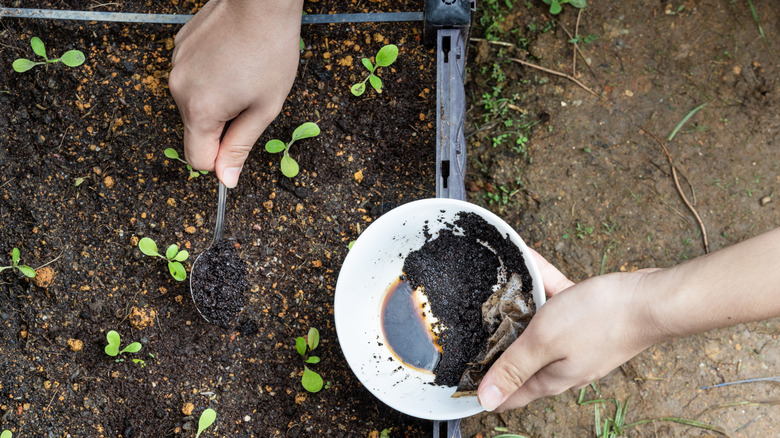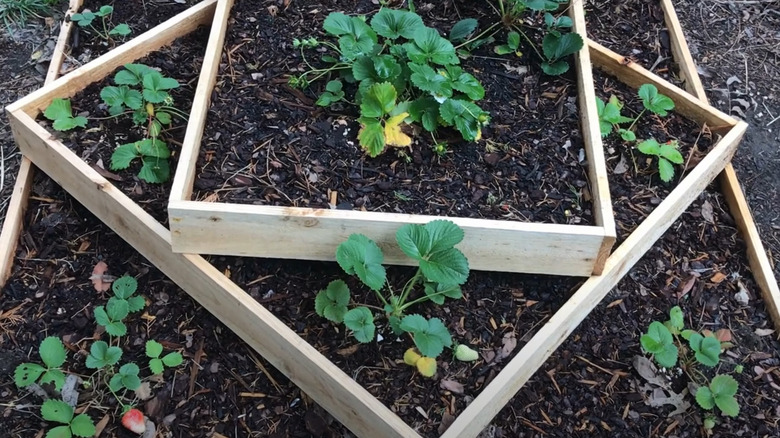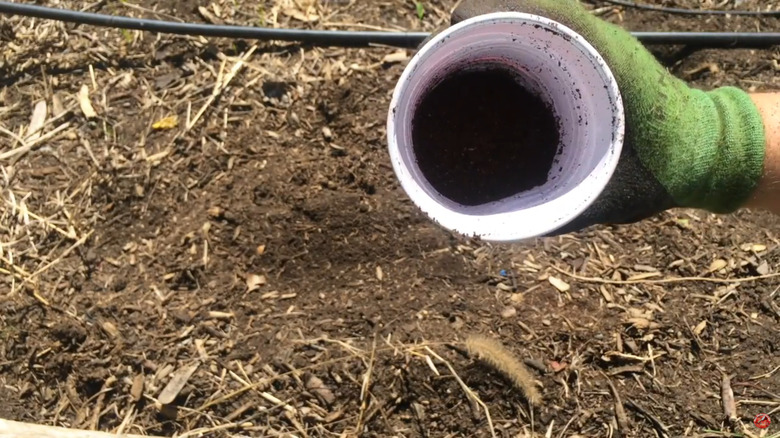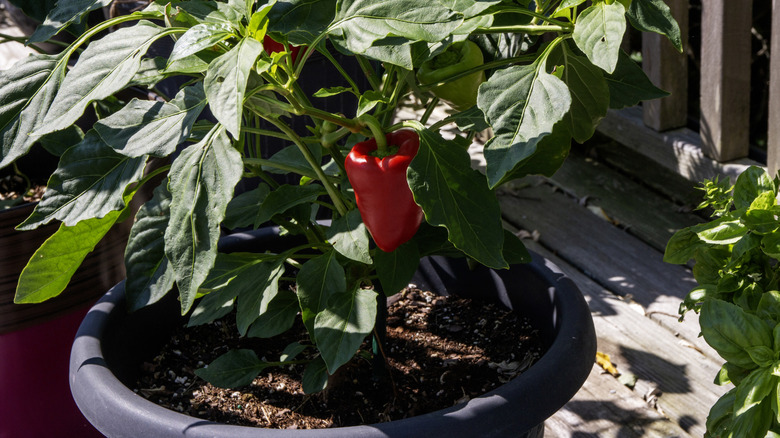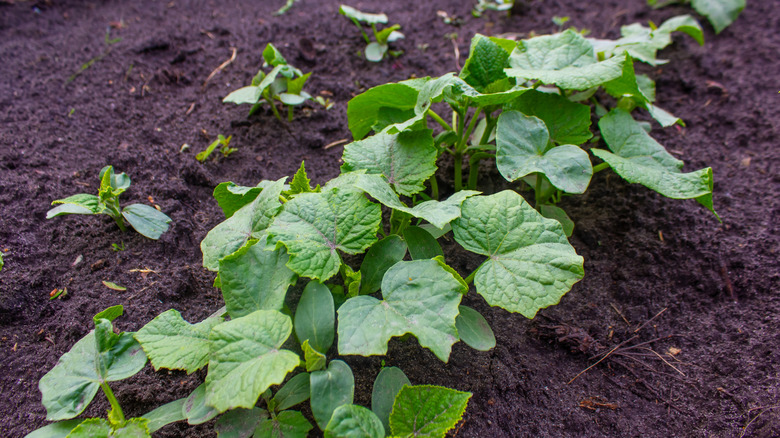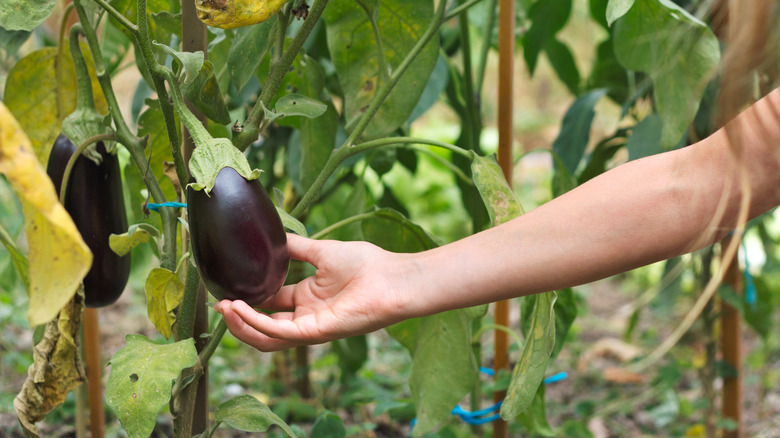6 Edible Plants You Can Add Coffee Grounds To For A Thriving Garden
We may receive a commission on purchases made from links.
Believe it or not, coffee grounds have a purpose outside of your everyday morning routine or afternoon pick-me-up. This unassuming beverage ingredient also has a place in home vegetable gardens. Coffee grounds contain nutrients and have soil-structure-boosting qualities that make them a great asset for growing a thriving garden of edible plants. Thanks to their nitrogen and carbon-rich nature, coffee grounds can benefit most vegetables, but there are some that can be particularly grateful for this gentle nitrogen boost.
The nutritional content in coffee grounds isn't crazy concentrated, but enough to make them a useful amendment, and not something to chuck away in the trash. However, although both edible plants and garden flowers thrive when you add coffee grounds to their soil, it's important to apply them the right way. If you're a bit of a caffeine fiend, and you dump your daily dose of spent coffee grounds onto a single area of the garden (or just a few raised planters), the grounds can form a caked layer on the surface of the soil that doesn't let moisture through. Excessive amounts of coffee grounds can also inhibit germination and stunt seedling growth of certain plants. Below, we get into six edible plants that can benefit from coffee grounds and tips on how to apply and use the grounds so they don't form a cake or stunt your plants.
Coffee ground mixtures can give strawberry plants a gentle boost
If you're dealing with sandy soil that's a little bit low in nutrients, coffee grounds can make for a free source of slow-release fertilizer, improving soil health at the same time. While strawberry plants need nitrogen to push out those cute little leaves, and photosynthesis to produce energy, they can be a little sensitive when it comes to nitrogen-rich, synthetic fertilizers. If you just dump a ton of nitrogen fertilizer on them, your strawberry plants will probably produce a lot of leaves and runners, and fewer flowers. Fewer flowers means lower yields, and fewer strawberries for all of your hard work. If you'd prefer to keep things natural, and simply reuse some kitchen waste rather than buying bags of NPK, then coffee grounds can be a great soil amendment for strawberry plants — one that's very unlikely to give them an overload of nitrogen. If you like to balance gardening with research, here's some interesting agricultural findings that show how well coffee grounds can work for boosting strawberry plants: In 2023 a study by the International Journal of Hospitality & Tourism Administration found that composted coffee grounds both improved strawberry germination rates, and triggered bigger and more plentiful harvests.
Like we mentioned above, it's important not to chuck excessive amounts of spent grounds directly around plants, as this can cause create an impermeable, caked, layer on the soil surface. If you are creating a new vegetable bed or container garden for strawberry plants, you can mix some saved grounds into the soil. Alternatively, compost the grounds first with leaves, grass clippings, and other natural organic materials before adding the compost to your strawberry beds.
Coffee grounds can help space out carrot seeds for less crowded germination
Many beginner gardeners struggle with growing carrots since the seeds are slow to germinate and time-consuming to thin out once they do develop. When carrot seeds are packed too tightly together, there's too much competition. This leads to spindly growth, and a whole lot of work thinning the seedlings out. One way to combat this is by mixing carrot seeds with coffee grounds when you plant them. The mixture ensures there's extra spacing between carrot plants and a nitrogen source to promote healthy growth. Adding coffee grounds as an amendment may even lead to even bigger carrots, which is the goal of any aspiring gardener!
Mixing coffee grounds with carrot seeds is (as you can imagine) not an exact science. The first step is to dry out the spent grounds. Then try either one part coffee grounds to four parts compost before adding in the carrot seeds, or equal proportions of seeds and dried coffee grounds. Drop the mixture into loose but even soil, ensuring the seeds are at least ⅛- to ¼-inch deep in the soil and coffee mix. As we mentioned earlier, there are reports that coffee grounds can impact germination, but this hack is still worth a try because carrot seeds are so fine that the most common mishap is planting too many, too close together. If the coffee grounds do inhibit some germination, you might not even notice this with all of the other carrot seedlings popping up.
A sprinkle of coffee grounds promotes healthy bell pepper plant growth
Bell peppers are another plant that can benefit from those spent grounds coming out of your kitchen. One of the main reasons why people sprinkle coffee grounds on bell pepper plants is to give them a mild nitrogen boost. Home gardeners often swear by this trick, and a 2012 Southern Illinois University study found that coffee grounds increased chlorophyll production, which boosted the overall plant height for bell peppers. More chlorophyll means plants have more energy, which can improve growth. This can ultimately lead to healthier and more productive plants. Like many other vegetables, bell peppers do well with an ongoing but controlled dose of nitrogen. This makes coffee grounds, which contain around 2% nitrogen, a handy amendment. Coffee grounds offer a subtle, slow-release source of nitrogen that isn't likely to trigger excessive leafy growth, which can negatively affect fruit set in bell pepper.
If you want to try applying the grounds directly to your pepper plants, be careful not to overdo things: Aim for a light sprinkling and don't exceed more than a few ounces for every square foot. If you can, try to work the grounds into the soil with your fingers or a small trowel without disturbing the roots of the pepper plants. This will be easiest when the plants are young, and have less extensive root systems. Uncomposted coffee grounds will require extra time to break down before they start releasing nitrogen to the plants, so amending the soil in the early stages is ideal. You can also compost the coffee grounds, together with other materials, and then apply the compost to your bell pepper plants.
Coffee grounds aren't an all-round fertilizer and won't provide full nutrition for bell pepper plants, which require a small ratio of nitrogen combined with higher, and equal amounts of phosphorus and potassium; for example, 1-2-2. To round out your feeding schedule, you'll almost want to apply other natural amendments like bonemeal any maybe even a store-bought fertilizer option like like Cz Garden Supply's 5-10-10 Tomato & Vegetable Fertilizer.
Tomato plants thrive with a modest layer of coffee grounds
You can also use coffee grounds to give tomato plants a boost. Tomato plants need nitrogen from early development, and their need for this nutrient peaks just before flowering. However, too strong a dose of nitrogen can cause tomato plants to grow too vigorously, flower poorly, and produce overly large fruit which are more prone to bursting and cracking. Not only are coffee grounds a gentle, slow-release form of nitrogen (so applying them is not likely to result in any of these issues), but they also contain other key nutrients tomatoes need, such as calcium.
One way to feed your tomato plants coffee grounds is to top dress the soil with a thin sprinkling. If you're busy planting out young tomato plants into the ground or preparing potting soil for them, you can also mix some coffee grounds into the hole and the surrounding soil, along with any other goodies (such as bone meal). Just don't go overboard: you want to aim for a few ounces per square foot or hole. Besides helping to feed your tomato plants, the coffee grounds will also work to improve the soil structure, and may attract extra earthworms. As microbes break down the grounds, their secretions contribute to that well-draining, light, and airy soil structure that tomato plants love.
While coffee can benefit tomatoes, it's not a complete fertilizer source. For further feeding and enhanced soil structure, you'll want to add lots of compost and maybe even something like the aforementioned fertilizer mixture if your soil mix isn't very rich. If you opt to add store-bought fertilizer, here is a guide on how often to fertilize tomato plants, depending on their growth stage.
Soaked coffee grounds can speed up the growth of cucumber seedlings
If you're wondering will coffee grounds help my cucumber plants as well, they can, but you might need to be careful how you apply them if your plants are still young. A 2023 Springer Nature study observed that fresh coffee grounds didn't help cucumber seed germination rate or seedling growth. However, when the spent grounds were soaked in water for 30 days and applied to young and sprouted plants, they were beneficial. Seedlings that underwent this treatment were overall larger, with more leaf area, and healthier compounds in their leaves and were able to carry out photosynthesis more efficiently.
This is an easy application method to try, all you need to do is combine the grounds with water, leave them to sit for a month, and then water the liquid onto your cucumber plants. Alternatively, if your cucumber plants are already established, and you don't have time to soak the grounds for 30 days, you can simply spread a small amount on the soil surface. We wouldn't try to dig the grounds in if your cucumber vines are beyond seedling stage, as cucumber plants have very shallow root systems. And lastly, you can choose to simply compost your grounds, and use that to improve the soil next time you plant a crop of cukes.
Eggplants have higher yields with coffee grounds
There's one last garden veggie to save your coffee grounds for. A 2023 Academia study found that liquid fertilizer created with coffee grounds improved the growth and production of eggplants in container gardens. Coffee grounds were second best to eggshells and worked well as an organic liquid fertilizer.
Aside from mixing coffee grounds with water to make a liquid fertilizer, coffee grounds can be a potential ingredient for DIY garden mulch. Eggplant bushes are pretty slow to establish, and don't do well with weed competition. Unlike, say, a robust, rambling pumpkin plant that can clamber over weeds, eggplants can't muscle out competition and so do well with some mulch to stop weeds from overrunning them. This also helps to conserve water in the soil, which is essential for big, non-bitter fruit.
Although coffee grounds can be a nutritious ingredient to mulch with, you have to be careful not to make that layer too thick. A thin layer of coffee grounds might smother weeds, but an overly thick one can turn into an impermeable cake, as we mentioned early. Therefore, don't make the layer more than ½-inch deep, and only apply the grounds after your plants have already sprouted, just in case they impact germination. You'll also want to top this off with a coarser mulch material, like straw, to stop the grounds drying out and forming that water-resistant, caked layer over the soil. Finally keep in mind that coffee grounds alone might not be able to meet the nutritional needs of your eggplants. In the 2023 study, the researchers noted that eggplants given traditional fertilizers outperformed those given coffee grounds. If you want to add some regular fertilizer into the mix, go with a balanced fertilizer or something that has a 5-10-5 ratio like Espoma's 5-10-5 Garden Food.
